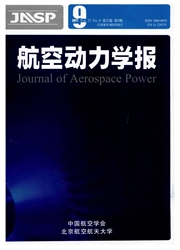

 中文摘要:
中文摘要:
未修形直齿锥齿轮啮合时为线接触,为减小两齿面啮合对安装误差敏感性,对主动轮齿面采用鼓形修形,改变刨刀运动轨迹进行齿向抛物线修形、改变瞬时滚比进行齿廓修形,从而实现两齿面点接触啮合.为进一步降低安装误差的敏感性,以齿廓、齿向修形系数为优化变量,减小接触迹线上啮合点的差曲面高斯曲率波动,同时增大参考点的差曲面高斯曲率值,降低安装误差敏感性;为避免齿面接触应力过大,控制参考点的差曲面主曲率,保证瞬时接触椭圆的长度不小于齿宽的1/3.算例分析及加工和滚检实验显示:经过优化设计后的修形齿面安装误差敏感性较低,总轴向错位量和总轴向分离量分别达到法向模数的30%,齿面印痕仍具有较好的稳定性.
 英文摘要:
英文摘要:
Modified tooth surfaces of one of the members of the straight bevel gear set were proposed in order to low the installation error sensitivity and improve the stability of contact patterns. Profile modification was carried out by changing the trajectory of the cutter from line to parabolic; tooth trace modification was carried by changing the roll, so the mod- ifield tooth surface with drum shape could be obtained and the gear set could mesh with point contact. In order to further improve the meshing stability, the optimization model for tooth surface modification was proposed. The two modification coefficients were used as optimal variables; the Gauss curvatures of two meshing surfaces at contact points were controlled to construct the objective function, and the principal curvatures of the ease-off tooth surface at the contact point were controlled to ensure that the length of the instantaneous contact el- lipse is at least 1/3 of tooth width. Finally numerical example of design of straight bevel gear drives was included to illustrate the advantages of the proposed geometry. A cutting and rolling experiments validate that the patterns maintain good stability with amount of the total axial misalignment and total axial separation accounted for 30% of the normal module.
 同期刊论文项目
同期刊论文项目
 同项目期刊论文
同项目期刊论文
 期刊信息
期刊信息
